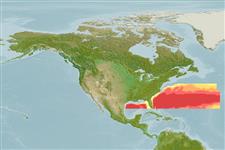>
Stomiiformes (Lightfishes and dragonfishes) >
Stomiidae (Barbeled dragonfishes) > Melanostomiinae
Etymology: Eustomias: Greek, eu = good + Greek, stoma = mouth (Ref. 45335).
Environment: milieu / climate zone / intervalo de profundidade / distribution range
Ecologia
marinhas batipelágico; intervalo de profundidade 0 - 3000 m (Ref. 11333). Deep-water; 40°N - 25°N
Western Central Atlantic.
Tamanho / Peso / Idade
Maturidade: Lm ? range ? - ? cm
Max length : 13.7 cm SL macho/indeterminado; (Ref. 11333); 15.0 cm SL (female)
Raios dorsais moles (total) : 22 - 25; Raios anais moles: 35 - 42. Two terminal bulbs separated by a long interspace (usually 2-3 times length of distal bulb, but up to 7.5 times in some small specimens). Barbel 60-85% SL in over 10 cm specimens. Terminal filament long, rarely with 1 or 2 short branches. Distal bulb usually 1-1.6 times length of proximal bulb (0.5-2 times in small specimens). Axis of stem pigmented, usually dark. External chevron-shaped or striated areas on stem usually pigmented in specimens larger than 8 cm. Paired dorsal spots between occiput and dorsal-fin origin usually 9, sometimes 7 (Ref. 11333).
Body shape (shape guide): elongated; Cross section: compressed.
Life cycle and mating behavior
Maturidade | Reprodução | Desova | Ovos | Fecundidade | Larvas
Gibbs, R.H. Jr., T.A. Clarke and J.R. Gomon, 1983. Taxonomy and distribution of the stomioid fish genus Eustomias (Melanostomiidae), I: subgenus Nominostomias. Smithson. Contrib. Zool. 380:139 p. (Ref. 11333)
Categoria na Lista Vermelha da IUCN (Ref. 130435: Version 2025-1)
Ameaça para o homem
Harmless
Utilização humana
Pescarias: sem interesse
Ferramentas
Relatórios especiais
Descarregue XML
Fontes da internet
Estimates based on models
Preferred temperature (Ref.
123201): 4.6 - 13.7, mean 8.7 °C (based on 78 cells).
Phylogenetic diversity index (Ref.
82804): PD
50 = 0.5000 [Uniqueness, from 0.5 = low to 2.0 = high].
Bayesian length-weight: a=0.00302 (0.00116 - 0.00786), b=3.12 (2.89 - 3.35), in cm total length, based on LWR estimates for this (Sub)family-body shape (Ref.
93245).
Nível Trófico (Ref.
69278): 4.2 ±0.73 se; based on food items.
Resiliência (Ref.
120179): Médio, tempo mínimo de duplicação da população 1,4 - 4,4 anos (Assuming tmax>3).
Fishing Vulnerability (Ref.
59153): Low vulnerability (10 of 100).
🛈
